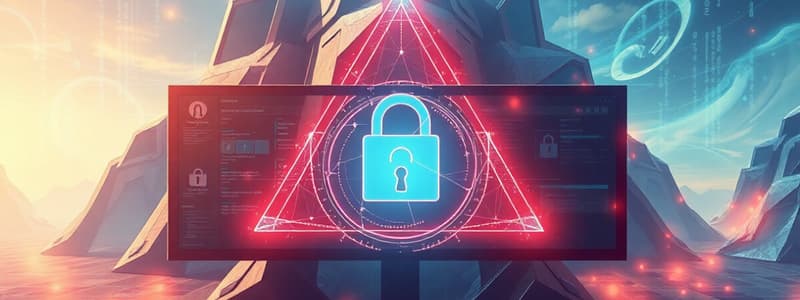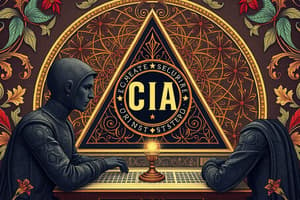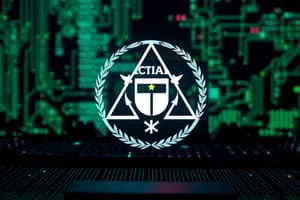Podcast
Questions and Answers
Which characteristic of security ensures that a party cannot deny the authenticity of their actions?
Which characteristic of security ensures that a party cannot deny the authenticity of their actions?
- Integrity
- Authentication
- Nonrepudiation (correct)
- Confidentiality
In the context of the C-I-A triad, which option directly relates to the protection of data from unauthorized access?
In the context of the C-I-A triad, which option directly relates to the protection of data from unauthorized access?
- Confidentiality (correct)
- Authentication
- Availability
- Integrity
What does the formula 'Who + What + How = Yes/No' refer to in security?
What does the formula 'Who + What + How = Yes/No' refer to in security?
- Data encryption standards
- Authentication process
- Access Control Policy (correct)
- Community access controls
Which of the following best describes integrity in the context of security?
Which of the following best describes integrity in the context of security?
Which of these is NOT considered part of the C-I-A triad?
Which of these is NOT considered part of the C-I-A triad?
What does interception refer to in the context of threats?
What does interception refer to in the context of threats?
Which option best describes the term modification?
Which option best describes the term modification?
What is the result of an interruption in a system?
What is the result of an interruption in a system?
Which of the following best exemplifies fabrication?
Which of the following best exemplifies fabrication?
In the MOM framework, which element represents the reason behind a threat?
In the MOM framework, which element represents the reason behind a threat?
What can weak encryption lead to in a security context?
What can weak encryption lead to in a security context?
Which of the following is NOT considered a type of software control?
Which of the following is NOT considered a type of software control?
What is the purpose of development controls in software security?
What is the purpose of development controls in software security?
In the context of operating system and network controls, what does 'chmod' refer to?
In the context of operating system and network controls, what does 'chmod' refer to?
Why is it important for software controls to influence usability?
Why is it important for software controls to influence usability?
What is the main purpose of independent control programs?
What is the main purpose of independent control programs?
What risk arises from improper use of encryption?
What risk arises from improper use of encryption?
What does penetration testing aim to achieve in computer security?
What does penetration testing aim to achieve in computer security?
What is the primary goal of computer security?
What is the primary goal of computer security?
Which of the following is NOT considered an asset of a computer system?
Which of the following is NOT considered an asset of a computer system?
Which of the following best describes the C-I-A Triad?
Which of the following best describes the C-I-A Triad?
What term refers to weaknesses in a computer system that can be exploited by threats?
What term refers to weaknesses in a computer system that can be exploited by threats?
In the context of computer security, what does 'access control' refer to?
In the context of computer security, what does 'access control' refer to?
Which of the following is considered a hardware asset in a computer security context?
Which of the following is considered a hardware asset in a computer security context?
What is an example of a software asset?
What is an example of a software asset?
Which of the following is NOT a category of data assets in computer security?
Which of the following is NOT a category of data assets in computer security?
Which control is an example of a physical control used to enhance security?
Which control is an example of a physical control used to enhance security?
What principle emphasizes that security can be no stronger than its weakest component?
What principle emphasizes that security can be no stronger than its weakest component?
Why is it important for users to be aware of security problems?
Why is it important for users to be aware of security problems?
What is a critical aspect of the effectiveness of security controls?
What is a critical aspect of the effectiveness of security controls?
What is one of the potential weaknesses of relying solely on hardware or software for security?
What is one of the potential weaknesses of relying solely on hardware or software for security?
How can periodic reviews enhance security measures?
How can periodic reviews enhance security measures?
Which of the following does NOT fall under the category of controls to address vulnerabilities?
Which of the following does NOT fall under the category of controls to address vulnerabilities?
What should be prioritized to maintain the effectiveness of security controls?
What should be prioritized to maintain the effectiveness of security controls?
Flashcards are hidden until you start studying
Study Notes
What is Computer Security?
- Protects the assets of a computer system, including hardware, software, and data.
Assets
- Hardware: Computers, devices (disk drives, memory, printer), network gear.
- Software: Operating system, utilities (antivirus), commercial applications (word processing, photo editing), individual applications.
- Data: Documents, photos, music, videos, emails, class projects.
C-I-A Triad
- Confidentiality: Ensures that information is only accessible to authorized individuals.
- Integrity: Guarantees that data is accurate and has not been tampered with.
- Availability: Makes sure that information and resources are available to authorized users when needed.
- Authentication: The process of verifying the identity of a user or device.
- Nonrepudiation: Ensures that the sender of a message cannot deny having sent it.
Access Control
- Determines who has access to what resources and how they can access them.
Types of Harm
- Interception: Unauthorized access to data.
- Interruption: Loss, unavailability, or unusable state of a system asset.
- Modification: Tampering or forging of data.
- Fabrication: Creation of counterfeit objects on a system.
MOM (Method - Opportunity - Motive)
- Explores the means, opportunity, and motivation behind threats to security.
Controls Available
- Encryption: A way to protect data by transforming it into an unreadable format. If used improperly, it can have no effect or even degrade system performance.
- Software/Program Controls:
- Internal program controls: Security restrictions within programs (example: access limitations in a database management program).
- Operating system and network system controls: Security enforced by the operating system or network (example: chmod in UNIX).
- Independent control programs: Applications that protect against vulnerabilities (example: password checkers, intrusion detection utilities, virus scanners).
- Development controls: Quality standards for designing, coding, testing, and maintaining software to prevent vulnerabilities (example: penetration testing).
- Hardware Controls: Devices and technologies used for security, including encryption implementations, access control locks, identity verification systems, firewalls, intrusion detection systems, and storage media controls.
- Policies and Procedures: Agreed-upon guidelines and rules among users (example: frequent password changes).
- Physical Controls: Measures to protect physical assets (example: locks, guards, backup copies, site planning).
Effectiveness of Controls
- Awareness of Problem: Users must understand the need for security to willingly comply with requirements.
- Likelihood of Use: Controls are only effective if they are used.
- Principle of Effectiveness: Controls must be efficient, easy to use, and appropriate.
- Overlapping Controls: Multiple controls may be used to address a single vulnerability.
- Periodic Review: Security measures must be constantly updated to stay ahead of threats.
- Principle of Weakest Link: Security can only be as strong as its weakest link.
Studying That Suits You
Use AI to generate personalized quizzes and flashcards to suit your learning preferences.




